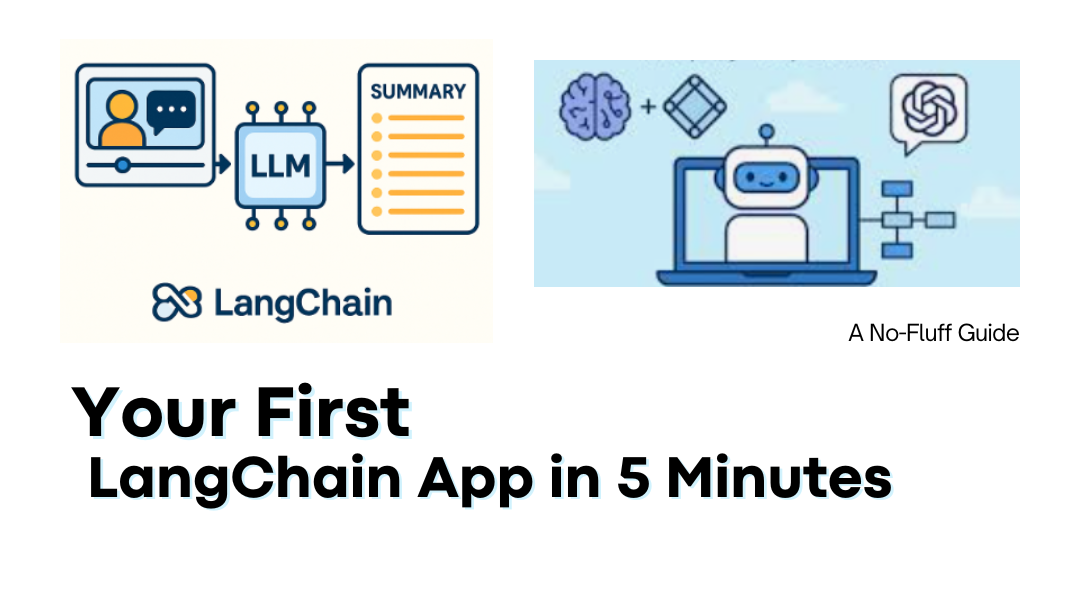Most AI tutorials overwhelm you with theory before showing anything useful. Not this one. In the time it takes to brew coffee, you’ll build a working LangChain app that personalizes greetings. No PhD required.
What We’re Building
A dead-simple AI greeter that:
- Takes a name (like “Sarah”)
- Generates a custom welcome message
- Spits out something like: “Hey Sarah! Ready to dive into LangChain?”
Here’s the entire code (we’ll break it down after):
python
Copy
Download
from langchain.llms import OpenAI
from langchain.prompts import PromptTemplate
from langchain.chains import LLMChain
# Set up the AI brain
llm = OpenAI(model=”gpt-3.5-turbo”, temperature=0.7) # Not too robotic, not too wild
# Create a Mad Libs-style template
prompt = PromptTemplate(
input_variables=[“name”],
template=”Yo {name}! LangChain’s gonna blow your mind. What’s up?”
)
# Wire them together
greeter = LLMChain(llm=llm, prompt=prompt)
# Test drive it
print(greeter.run({“name”: “Alex”}))
Output:
“Yo Alex! LangChain’s gonna blow your mind. What’s up?”
Why This Matters
This isn’t just a fancy “Hello World.” You’ve just built:
- Dynamic prompts (change “Alex” to any name)
- Controlled creativity (that temperature knob)
- A reusable pipeline (swap components later)
Line-by-Line for the Curious
- llm = OpenAI(…)
- This is your AI’s engine. gpt-3.5-turbo is cheaper/faster than Davinci.
- temperature=0.7 means “be fun but don’t go off the rails.” Try 0 for robot mode, 1 for drunk poet.
- PromptTemplate(…)
- The {name} part is a placeholder—like a blank in Mad Libs.
- Pro tip: Bad templates = bad outputs. “Write a tweet about {topic}” works better than “Say something about {topic}.”
- LLMChain(…)
- This marries the AI and template so they play nice together.
- Later, you can add memory or tools here without rewriting everything.
- .run({“name”: “Alex”})
- The magic happens here. LangChain:
- Slots “Alex” into the template
- Sends “Yo Alex!…” to GPT-3.5
- Returns GPT’s response
- The magic happens here. LangChain:
Where Newbies Get Stuck
- API Keys: Forgot to export OPENAI_API_KEY=’sk-…’? It’ll yell at you.
- Overengineering: Start small. Fancy memory/agents come later.
- Prompt Wrinkles: If output sucks, tweak the template first before blaming the AI.
Level Up: 2 Simple Tweaks
1. Add Emotions
Change the template to:
python
Copy
Download
“Say this excitedly: {name}! Dude. LangChain. Let’s. Go.”
Now it outputs:
“Alex! Dude. LangChain. Let’s. Go.”
2. Multi-Variable Prompts
python
Copy
Download
prompt = PromptTemplate(
input_variables=[“name”, “mood”],
template=”Hey {name}, you seem {mood}. Want a LangChain tip?”
)
print(greeter.run({“name”: “Jamie”, “mood”: “pumped”}))
Output:
“Hey Jamie, you seem pumped. Want a LangChain tip?”
Why This Beats Raw LLM Calls
Without LangChain, you’d be stuck doing:
python
Copy
Download
manual_prompt = f”Yo {name}!…” # Have fun keeping track of these
response = openai.ChatCompletion.create(…) # Good luck managing conversations
LangChain keeps you sane as your app grows.
What’s Next?
- Memory: Make it remember past convos
- Tools: Let it check weather/emails
- Agents: Have it decide when to use which tool
But today? Pat yourself on the back—you’ve just built something that would’ve taken 100x more code last year.
Pro Tip: Run pip install langchain openai python-dotenv first. Then steal this code and make it swear like a sailor (set temperature=1 and watch the chaos).
